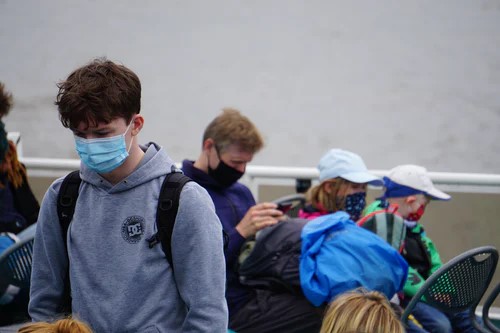04 June 2020
Get Closer
Don masks!
By Richard Pooley

Three friends disagreed with the message in my article last week: the UK needs to cut “social distancing” from two metres to one. Surely, they each argued, there’s less risk of infection the further apart we are from each other? Correct, I replied. Furthermore, there is now scientific evidence that they are right. The Lancet published on Monday a meta-analysis of nine studies of a total of 7,782 people who had to deal with other epidemics as well as Covid-19. This showed, with “moderate” certainty, that the risk of infection was 13% at one metre but down to 3% at two metres. And 1.5% at three metres. Even at six metres there is still a risk of infection, albeit a tiny one. My point was not that there was no more chance of catching Covid-19 at one metre than two. Clearly, the risk of infection is higher the closer people are to each other. But what is the level of risk which is acceptable and which allows people to resume working? There is always some risk. You may be ten metres away from an infected person but touch a railing or door handle a few seconds after they have, rub your eyes or nose and… bingo!… you’ve caught the virus too.
Furthermore, is there something else we all should be doing which makes it less risky to live and work more closely together? I hinted at the answer pretty strongly in last week’s article. Time to be explicit: wear a mask whenever in a public building or on public transport. The same Lancet report included a meta-analysis of ten studies of far fewer people (2,647), which is probably why the certainty level was deemed “low” and why it received far less publicity. These studies were of the effectiveness of wearing a mask during epidemics. The meta-analysis concluded that wearing a mask reduced the risk of infection from 17% to 3%.
A separate study by Japanese researchers shows that the odds of infecting someone else are nineteen times greater indoors than out in the open air. Which is why I was astonished this week to see a woman at my local Tesco Express take her mask off as she walked into the store, just as I was putting mine on. Still, I should have been glad she was wearing a mask at all. So few Brits seem to be doing so.
I lived in Japan with my family in the early 1990s. I ran my British company’s subsidiary in Tokyo and thoroughly enjoyed it. I remain a big fan of Japan and the Japanese, as loyal readers will know – Rugby in Japan. However, initially I had refused to go. This was partly because of my upbringing. My father could not forgive the behaviour of Japanese pilots strafing those of his shipmates who had taken to the water after his ship was torpedoed during the war in the Pacific. And some of my parents’ friends had barely survived as prisoners of war under the Japanese. But a big reason I baulked at going was my fear that we would be living in a vast, densely-crowded, highly-polluted city with very few green spaces. It would be a bad place to bring up young children. I met the person who I was supposed to be taking over from and voiced my concerns. How could he live in a place where the air was so polluted that everyone wore masks? He really did roar with laughter before putting me right. The Japanese, he told me, wear masks when they have a cold or are suffering from hay fever. They wear them so that in that sardine-packed subway train or crowded open-plan office they don’t infect others. It had nothing to do with air-pollution. As I soon discovered when visiting South Korea from Japan, the Koreans wore masks for the same reason (though it has to be said at that time the air in Seoul tasted polluted). I learned it was the same in China, Taiwan, Hong Kong and Singapore. Since then, Chinese city-dwellers and Singaporeans have had to don masks to protect themselves from polluted air too. But the reason all these Asian peoples have worn masks so readily during this Covid-19 pandemic is the same as I witnessed in the 1990s and on every visit to East Asia since: to reduce the risk of infecting other people.
Very early in the pandemic, Vietnam imposed a one metre social distancing rule and the compulsory wearing of masks in public, inside or out. Result: as of 29 May a country of 97 million people, with a population density of 813 per square mile, had had 328 Covid-19 cases and no deaths. That’s right. Zero deaths. The UK, a country of 68 million people, with a population density of 723 per square mile, has had close to 50,000 deaths attributed to Covid-19. Yes, Vietnam is run by an authoritarian Communist regime which makes it easier for lock-down rules to be enforced than in a democracy like the UK. And they had had direct experience of SARS, avian flu and other epidemics and so knew what the best course of action was to take. But, unlike Communist China, there is no evidence that the Vietnamese authorities have lied about the real extent of the disease in their country. They and their people have just managed it so much better than we or any other European nation have. So, why don’t we learn from them?
I proposed last week that we Brits follow the Danes in reducing the minimum social distance from two metres to one. After all, the infection rate has not noticeably increased since they did this. Or we could go one better and follow the Norwegians who on Monday this week welcomed children back to school with no social distancing required at all. Okay, both countries have done far better than the UK in coping with the pandemic. In the Scandinavian context, Norway has had 237 deaths attributed to Covid-19 (as at 29 May) and Denmark 568, compared to twice as populous Sweden’s 4,350. Norway and Denmark locked down early and hard. Sweden, famously or notoriously depending on your point of view, has had no lock-down. The UK locked down later than anyone else and not as toughly as some. Hence the infection rate remains far higher in the UK and Sweden than in countries like Denmark and Norway (and Greece and Cyprus and Austria and Finland and the Baltic countries and Germany. So why, Ms Patel, impose quarantine on anyone, including British expats, from these far less infected countries who are mad enough to want to come to blighted Blighty? What, pray, is the “Science” behind this?). British people are already breaking the two-metre social distancing rule. Why not, Mr Johnson, cut the distance to one metre and make it law that people wear masks in shops, offices, trains and buses? Now.
Or is there another reason why the British prime minister is against insisting we wear masks? Is it possible that he was so upset by the unjust accusation of racism which followed his August 2018 article in the Daily Telegraph that he does not want to revive the whole debate about face coverings? This was the article in which he defended the right of Muslim women to wear the burka and the niqab if they so wished, even though he himself regarded such clothes as “oppressive” and made their wearers “look like letterboxes and bank robbers.” As readers know, I can’t stand the charlatan. He has already shown himself to be ill-qualified to be the UK’s prime minister (though I am not sure there is anyone better qualified such is the lack of talent or leadership material among the ruling class). But he really did not deserve the opprobrium heaped upon his head by everyone from the then prime minister downwards. He was not being racist or anti-Islam. He was defending people’s freedom to choose what they wear. It would be a great pity (and deeply ironic) if this is the reason why he is not making it compulsory for Brits to wear masks.


